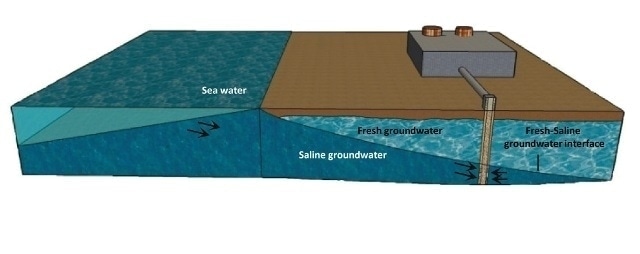Mar 3 2016
 A diagram showing where saline groundwater is extracted for desalination.
A diagram showing where saline groundwater is extracted for desalination.
A team of researchers from the Ben-Gurion University Zuckerberg Institute for Water Research, the BGU Department of Geological and Environmental Sciences, and the Israel Geological Survey have established that compared to seawater, saline groundwater obtained from coastal aquifers is a better water source for reverse osmosis (RO) desalination. The main reasons for this are the reduced pre-treatment costs and minimal membrane fouling. The research findings have been published in the Environmental Science & Technology journal.
Decision-makers in both California and Israel can use this research to seriously consider saline groundwater as a realistic alternative when planning future large-scale seawater desalination facilities. In Israel, seawater desalination accounts for 60% of the total freshwater supply, so these findings are significant.
Dr. Roni Kasher, Senior Lecturer, Department of Desalination and Water Treatment, BGU Zuckerberg Institute
BGU researcher Shaked Stein adds, “Saline groundwater results from seawater intrusion into coastal aquifers, shifting the fresh-saline water interface upward and landward, and replaces fresh groundwater with saline groundwater. The RO process in coastal aquifers will be helpful in restraining seawater intrusion.”
Saline groundwater has other advantages such as; lower levels of silt density, dissolved oxygen, and phytoplankton, as well as stable annual water temperatures. The cost of desalination is also reduced.
Seawater-based RO desalination process needs a high amount of energy, as well as a large plant area that is situated in a shorefront property; both of these factors raise the product water cost.
The study showed that aquifer filtration increases the feed water quality and reduces the need for extensive pre-treatment processes. RO desalination with saline groundwater as feed water is also more efficient, with higher freshwater recoveries, less chemical use and maintenance, and therefore less overall operational costs.
Shaked Stein, Researcher, BGU Zuckerberg Institute
Stein particularly advocates the use of saline groundwater during the summer, because the typical seasonal seawater fluctuations cause higher membrane fouling in summer as revealed in the research. “Salt rejection decreases in elevated temperatures due to changes in membrane permeability and mass transfer.”
In our study, we used normal (vertical) wells to take samples from the saline groundwater. All the wells were a maximum of 300 ft (100 m) from the shoreline. However, the water intake can be accomplished using several different types of wells.
Dr. Roni Kasher, Senior Lecturer, Department of Desalination and Water Treatment, BGU Zuckerberg Institute
Other researchers who took part in this study include Drs. Amos Russak and Orit Sivan, BGU Department of Geological and Environmental Sciences; Dr. Yoram Oren BGU Department of Desalination and Water Treatment, Zuckerberg Institute for Water Research; Dr. Yoseph Yechieli, Geological Survey of Israel; Dr. Eyal Rahav, Israel Oceanographic and Limnological Research, National Institute of Oceanography.